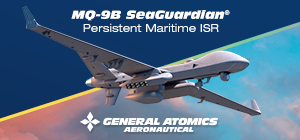Two mock-ups of Dassault’s UCAS have been presented officially at the Paris Air Show, one at the Dassault’s booth and the other at the Armée de l’Air’s static display. Dassault’s one (pictured) was in 1:1 scale and allowed for a first analysis of the new project.
The UCAS is scheduled to enter service around 2033, with a first flight expected a few years earlier. This timeline aligns with the planned introduction of the RAFALE F5, ensuring that both systems will be available to operate together from the outset. The development schedule includes several key milestones, including detailed design reviews, prototype construction, ground testing, and flight testing.
Dassault's UCAS features a flying wing design reminiscent of earlier nEUROn technology demonstrator, but with significant advancements in stealth technology and operational capabilities. According to insights gathered by FW MAG, Dassault has chosen to mirror the nEUROn design as during the different tests and measurement the airframe revealed outstanding stealth performance. Therefore, the aircraft's shape has been meticulously engineered to minimize radar cross-section, with clean lines and internal weapons bays that preserve its low-observable characteristics during combat operations. Unlike the smaller nEUROn demonstrator that weighed approximately 5-6 tons, the new UCAS is substantially larger, with a maximum take-off weight comparable to that of the first MIRAGE 2000 fighter jets - approximately 14-16 tonnes - making it one of the largest combat drones under development in Europe. Based on visual assessment, the aircraft has an estimated wingspan of approximately 12-14 meters and a fuselage length of around 10-11 meters. While Dassault has not disclosed all the specifications, FW MAG could understand that the French DGA would have disclosed the full specifications only to French magazine Air Fan – for unknown reasons.
The stealth features of the UCAS are designed specifically to enable operations in highly contested airspace, allowing it to penetrate sophisticated enemy air defence networks while remaining undetected. This capability is crucial for its primary mission of suppressing and destroying enemy air defences, a role that France has been actively seeking to rebuild within its air force. The French Air and Space Force disclosed plans to equip its aircraft for the SEAD/DEAD mission from 2030, with the UCAS playing a central role in this capability.
The UCAS will be managed from a co-pilot on RAFALE-B twin-seater jets. The co-pilot will not have to fly the drone directly but will play the role of a mission manager. The chosen level of automation is therefore an UCAV fully capable of flying the mission, yet with mission profiles and weapon engagements decided by a man in the loop. In principle, the same mission manager might control multiple drones, but this choice has not been made yet and will depend on the French Air Force. The control system must address several challenges, including maintaining situational awareness of both the RAFALE and the UCAS, managing communications in contested electromagnetic environments, and ensuring robust command and control links – and this will be possible only by robust AI algorithms. While specific details about the AI systems remain classified, French officials have indicated that the drone will be capable of autonomous navigation, target identification, and threat avoidance. These capabilities build upon the experience gained, once more, through the nEUROn program, which demonstrated autonomous flight, including carrier landings and aerial refuelling.
Hence, this manned-unmanned teaming approach allows the RAFALE to remain at safer distances while the UCAS penetrates heavily defended airspace to conduct high-risk missions.
The UCAS has been designed with significant range and endurance capabilities to support the RAFALE F5 in deep penetration missions. While specific performance figures have not been publicly disclosed, French officials have indicated that the system will be capable of operating at extended ranges from its home base, potentially reaching targets over 1,000 nautical miles away. To further extend its operational range, the UCAS would have been designed with aerial refuelling capability, though designers are still assessing whether it will employ a hose-and-drogue refuelling mechanism like the RAFALE or a probe-and-drogue approach. France's Airbus A330-based tanker fleet can support both mechanisms, providing flexibility in deployment options.
Like the RAFALE, the UCAS is being designed to operate from aircraft carriers, further extending its operational flexibility and deployment options. The ability to operate from carriers presents unique design challenges, including reinforced landing gear and arrestor hook systems, and maybe folding wings for efficient storage on the carrier deck.
The Dassault UCAS's propulsion system, featuring a single non-afterburning M88 engine, represents a carefully optimized solution for its intended mission profile. By eliminating the afterburner, the design achieves enhanced stealth characteristics, improved fuel efficiency, and simplified maintenance requirements. The M88 engine in its non-afterburning (dry) configuration delivers approximately 50 kN (11,250 lbf) of thrust. This represents a significant power plant for an unmanned system of this size, providing sufficient thrust for the UCAS's mission profile while maintaining a favourable thrust-to-weight ratio. The dry thrust configuration offers several advantages specifically tailored to the unmanned combat role. The decision to employ the M88 engine without afterburner affects several aspects of the UCAS design and performance envelope.
In fact, the M88 engine installation features a dorsal air intake positioned on the upper fuselage surface, a design choice that significantly reduces frontal radar cross-section by shielding the engine face from direct radar illumination. This intake configuration is optimized for a non-afterburning powerplant, with simplified ducting requirements compared to an afterburning variant. The exhaust system is specifically designed for non-afterburning operation, likely incorporating advanced cooling techniques to further reduce the aircraft's infrared signature. Without the need for variable geometry nozzles typically required for afterburning engines, the exhaust design can be more thoroughly optimized for radar cross-section reduction.
It is worth noting that Safran is simultaneously developing an enhanced version of the engine called the M88 T-REX for the RAFALE F5 fighter. This upgraded variant will deliver increased thrust of approximately 88.2 kN (19,841.6 lbf) with afterburner, representing a 20% increase over the current M88 engine. Nonetheless, the UCAS prioritizes stealth and endurance for its loyal wingman role, while the RAFALE F5 requires maximum performance across all flight regimes.








.png)
